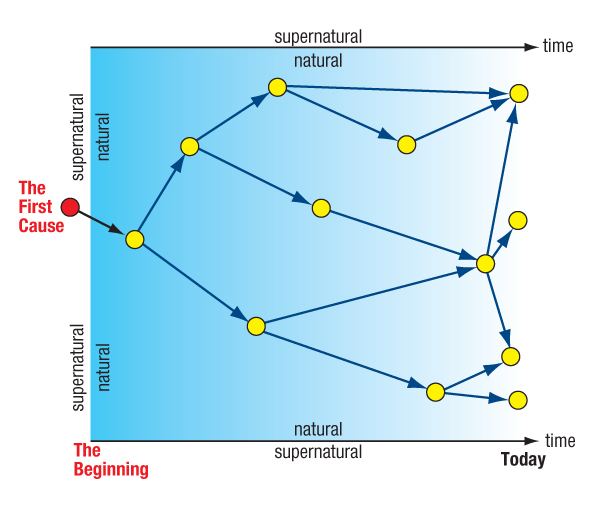Below is the online edition of In the Beginning: Compelling Evidence for Creation and the Flood,
by Dr. Walt Brown. Copyright © Center for Scientific Creation. All rights reserved.
Click here to order the hardbound 8th edition (2008) and other materials.
How Can the Study of Creation Be Scientific?

Figure 222: Causes and Effects. Each arrow’s tail represents a cause, and each yellow circle represents an effect. The arrow itself is the cause-to-effect relationship. Yellow circles also represent scientific evidence that to most people suggests a creation and a global flood. All of us, including students, should be free to reach our own conclusions about origins after learning the evidence and all reasonable explanations. Withholding that information in schools and misrepresenting it in the media are inexcusable.
The first cause appears to be supernatural, or beyond the natural (blue area). Evolutionists often say that the yellow circles and their scientific implications cannot be presented in science classrooms, because the first cause (red circle) is supernatural. Subjects outside the natural (including biblical descriptions of creation and the flood that are so consistent with the physical evidence) are inappropriate for publicly financed science education. However, excluding what is observable and verifiable in nature, along with possible causes, is bad science, misleading, and censorship. Creation science, then, is the study of this scientific evidence.
Let me define science.
science: A field of study, using observations and experiments, to better understand natural phenomena.
Broad, but increasingly precise and concise, relationships (usually mathematical) are sought between causes and effects. These relationships, called scientific laws, help predict future phenomena and explain past events.
Notice, this does not mean that the first cause must be naturalistic. It is poor logic to say that because science deals with natural, cause-and-effect relationships, the first cause must be a natural event. Furthermore, if the first cause were a natural consequence of something else, it would not be the first cause. An infinite series of events would have preceded it—with no first cause. Scientific laws can give great insight on ultimate origins although the first cause cannot, by definition, be duplicated. Yes, there was a miraculous beginning. [See Items 53 and 55 on page 33.]
Scientific conclusions, while never final, must be based on evidence.
scientific evidence: Verifiable measurements or observations that support or oppose possible physical explanations.
All evidence in Parts I and II of this book is based on observable, natural phenomena that others can check. (This book also contains 58 testable and potentially falsifiable predictions.) To most people, this evidence implies a creation and a global flood. This does not mean that the Creator (The First Cause) can be studied scientifically or that the Bible should be read in public-school science classes. (I have always opposed that.) Those who want evolution taught without the clear evidence opposing it, in effect, wish to censor a large body of scientific evidence from schools. That is wrong. Also, the consequences of a global flood have been misinterpreted as evidence for evolution, not as evidence for a flood. That misinterpretation, unfortunately, is taught as science. [See Part II.]
Explanations other than creation or a global flood may someday be proposed that are (1) consistent with all that evidence and (2) demonstrable by repeatable, cause-and-effect relationships. Until that happens, those who ignore known evidence are being quite unscientific. Evolutionists’ refusal to debate this subject (see pages 588–589) and their speculations on cause-and-effect phenomena that cannot be demonstrated also show poor science, especially when so much evidence opposes those speculations.
Evolutionists raise several objections. Some say, “Although evidence may imply a sudden beginning, creation is supernatural (not natural) and cannot be entertained as a scientific explanation.” Of course, no one understands scientifically how the universe came into existence—how space, time, matter, and the laws of physics began. [See Figure 250567 and the paragraph preceding that figure.] Others, not disputing that the flood best explains many features on earth, object to a global flood, because the Bible—a document they may reject—speaks of such a flood. Still others object to the starting point for the flood (given on page 122), but in science, all starting points are possibilities. The key question must always be, “What best explains all the evidence?”
Also, the source of a scientific idea does not need to be scientifically derived. For example, Friedrich Kekulé discovered the ring structure of benzene in a dream in which a snake grabbed its tail. Kekulé’s discovery laid the basis for structural chemistry. Again, what is important is not the source of an idea, but whether all evidence supports it better than any other explanation. Science, after all, is a search for truth about how the physical universe behaves. Therefore, let’s teach all the science.